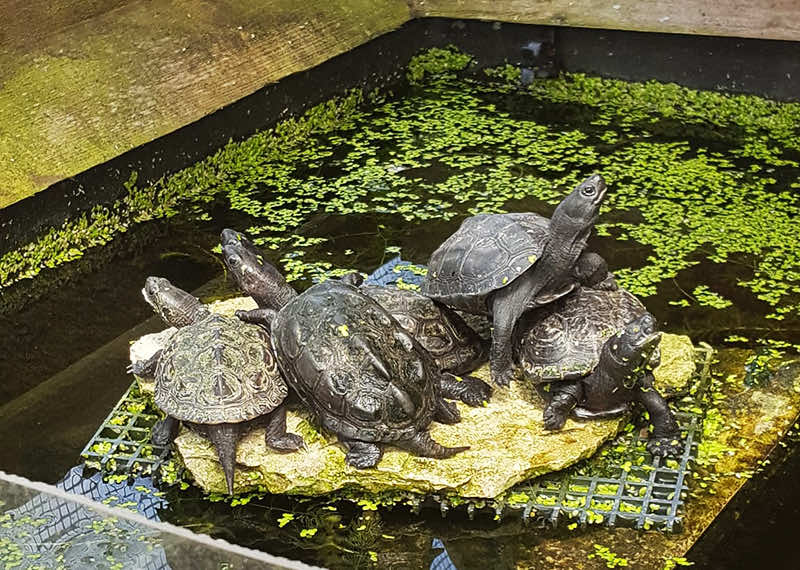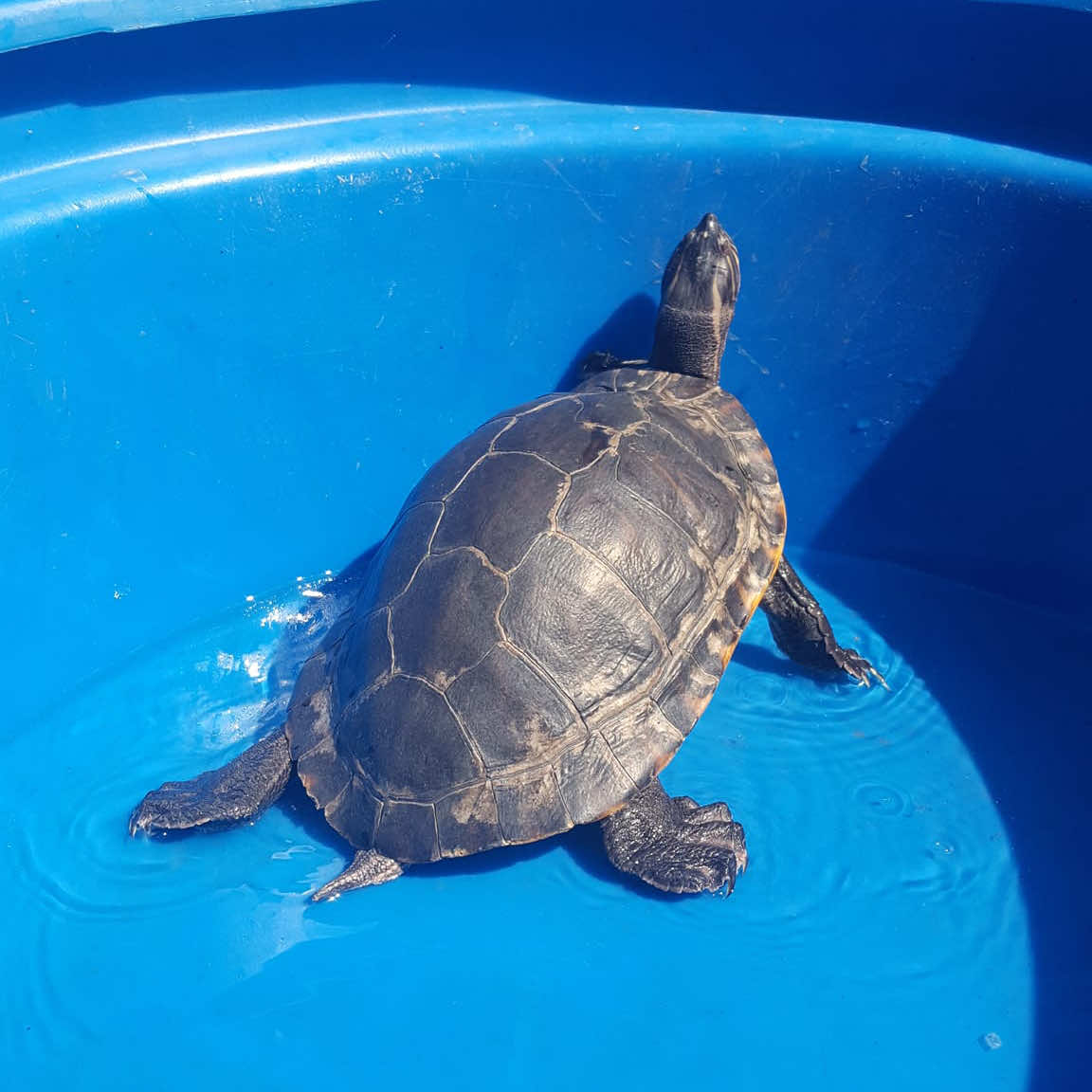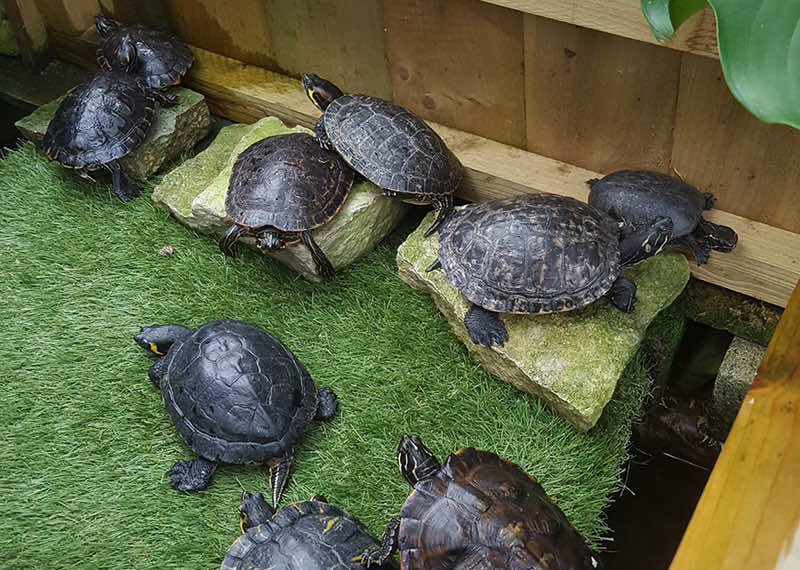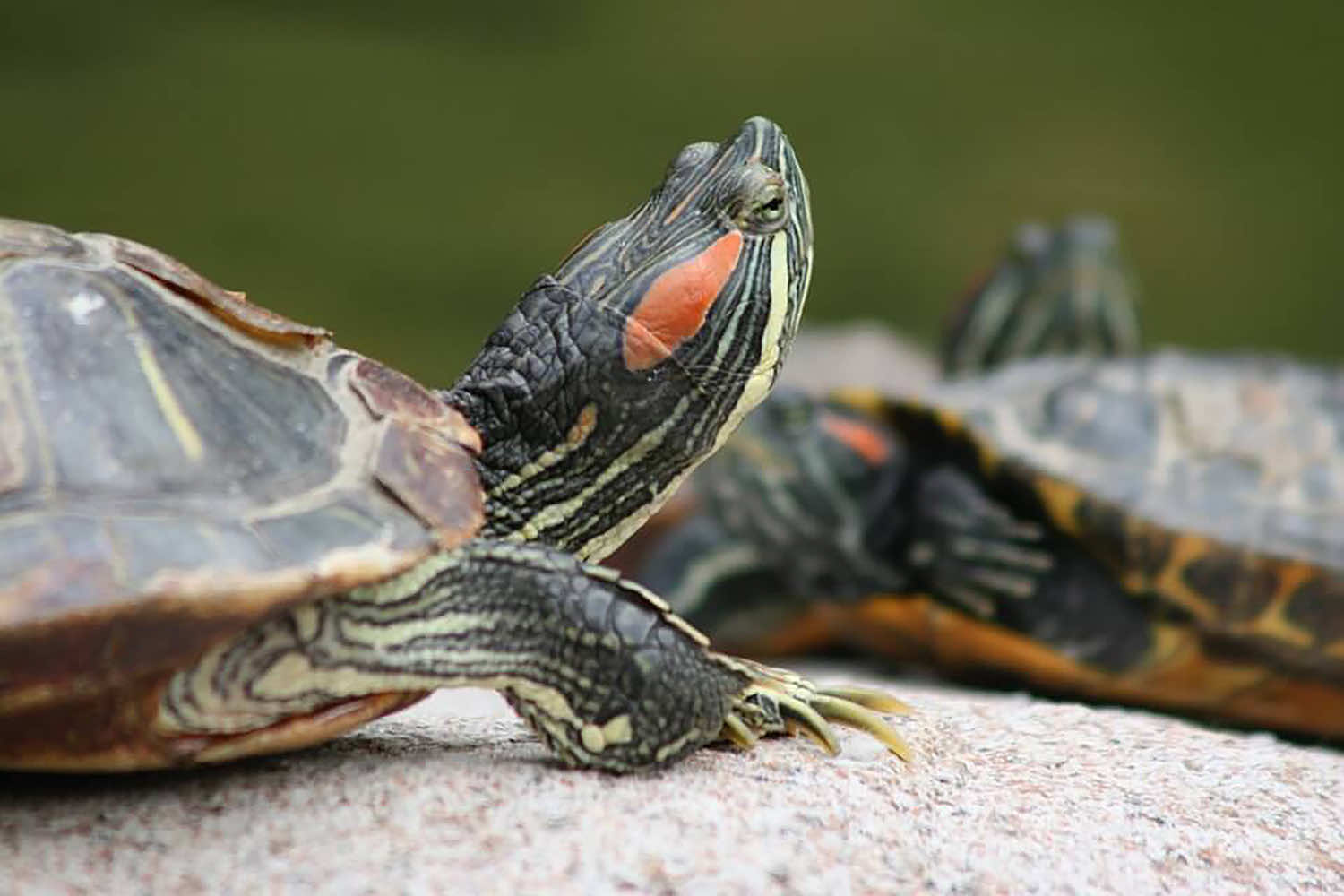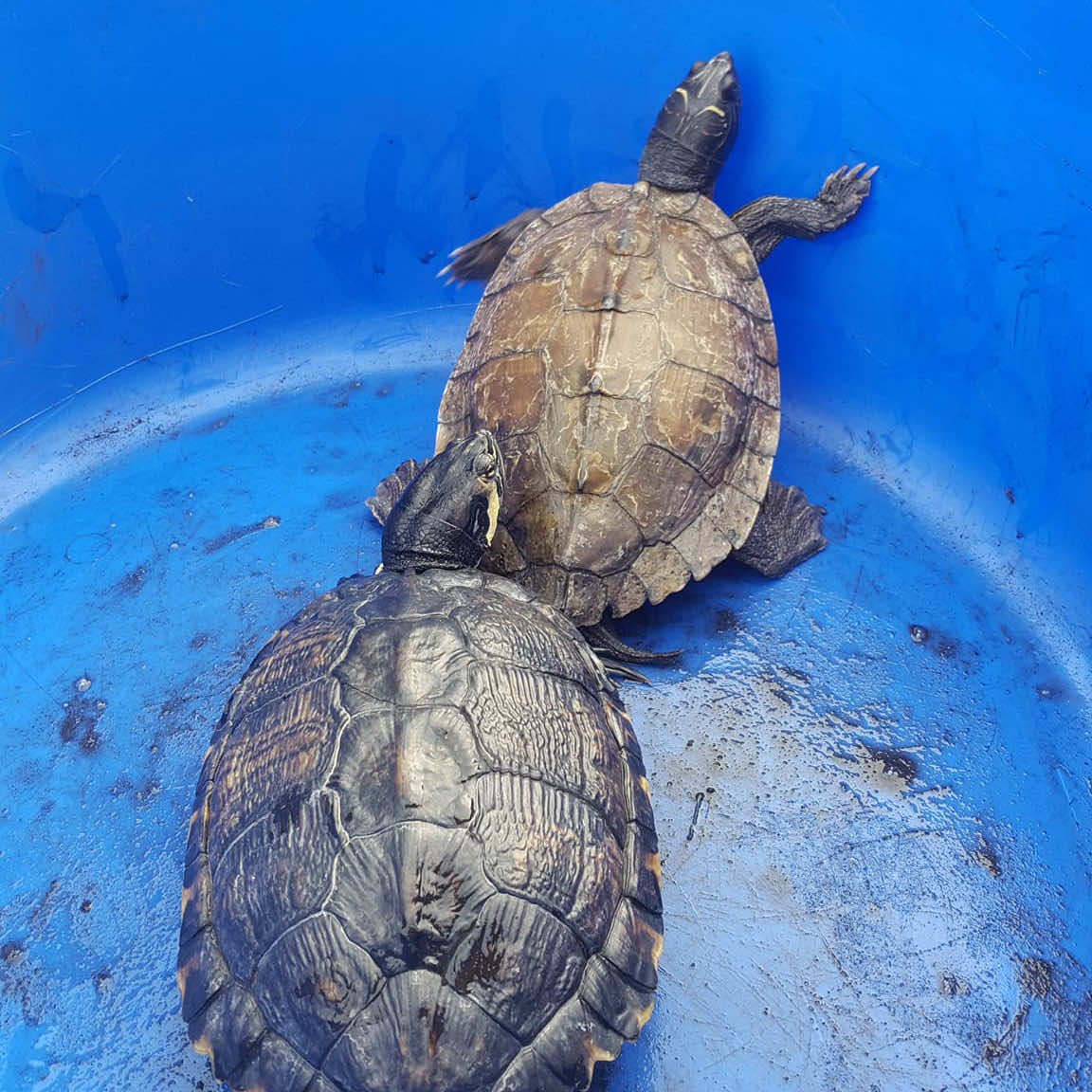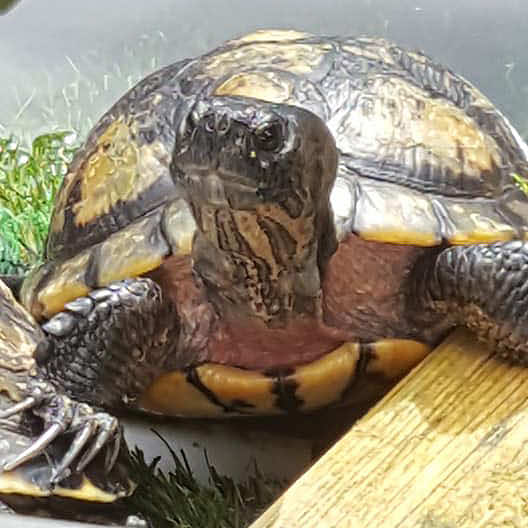THE ORIGIN OF TURTLE PARADISE
Hi everyone my names keith and owner of turtle paradise boarding for the welfare of turtles in the uk. This is my story of how I got into turtles and ups downs of keeping them.
Back in the late 70s, an intriguing journey began when I paid a visit to my local pet shop in search of koi food. Koi were a new and fascinating addition to the scene, but that’s a tale for another time. As I wandered through the shop, my eyes fell upon a tank teeming with small green turtles, known simply as terrapins before the Ninja Turtle craze took hold. Intrigued, I engaged in a conversation with the shop owner and ended up purchasing two of these delightful creatures.
Initially, I was assured that a 3ft tank would suffice, so I set it up as I would for tropical fish. However, within a few weeks, the tank’s plants were gone, and their diet mainly consisted of koi food and krill, as the options were limited, and the internal filter couldn’t keep up. Realizing I needed more information, I embarked on a quest for knowledge. In those days, the internet was nonexistent, so off to the library I went. I had to order reference books to identify the turtle species I had acquired. Soon enough, I discovered they were red-eared sliders capable of growing up to 13 inches in length. It became evident that a 3ft tank wouldn’t suffice.
Armed with newfound knowledge about the species, I set out to find a larger tank. Fortunately, someone known to my father, who worked in the dusty realms, stumbled upon a perfect solution. Fish tanks in those days came with sturdy metal frames, and this particular one measured 6ft x 2ft x 2ft, an impressive and weighty structure. With kindness and determination, it was delivered to my abode, and with the assistance of three others, we managed to position it beneath a Leanto in the back garden. It was fortunate that we did, as the tank suffered from leakages due to deteriorated putty, which had been the norm for tank construction during that era. So, the putty had to be redone, and once that task was completed, the two red-eared sliders found their new home within the tank, where they thrived for many years.
However, as the late 80s approached, life took me on a different path, and circumstances necessitated finding a new home for my beloved turtles. I express my gratitude to Chessington Zoo, who kindly agreed to welcome and care for them. It was a bittersweet farewell, but knowing that they would be well looked after brought solace to my heart.
Fast forward to 2003, after working in the NHS for 13 years, I found myself considering a new career path due to the decline of the healthcare system. During this time, the government mandated that everyone in the NHS had to attend a “back to school training course.” The catch was that you couldn’t learn anything you already knew or were currently doing. Feeling a desire to start my own aquatics business, I decided to enrol in a City and Guilds pet shop management course, fully funded by the NHS.
As I delved into the course, I came across the reptile section, which provided valuable information on caring for snakes, lizards, geckos, and so on. However, when it came to turtles, the information was lacking. The only guidance provided was to keep them in clean water, use a water heater, and provide a basking area with a heat lamp. The suggestion of keeping hatchlings in a 2-3ft tank with 12 of them seemed rather disappointing. Nonetheless, I completed the course and gained knowledge in water quality, filtration, fish biology, and healthcare to support my new business venture.
A few years later, in 2007, we relocated from Middlesex to Dorset. After dedicating seven years of my career to Sunseekers in 2014 I decided to embark on a new venture and establish my own pond business. I began building and maintaining ponds as part of my business, it was during this time that one of my daughters surprised me by announcing her plan to get a pair of turtles for her flat. These turtles were two six-inch yellow-bellied sliders that arrived in a four-foot tank with an internal filter. With my newfound knowledge, I had a good understanding of the challenges she would face with two turtles in a tank of that size and inadequate filtration. I offered to set up an external filter if she would invest in a larger tank. She agreed, and six months later, the two yellow-bellied sliders were on their way to me, as she found it difficult to manage their needs.
I set up a decent holding tank in my shed, where they would stay until they acclimated to eventually join my pond. Two weeks later, my daughter called to check on their well-being and surprised me once again by asking if I would take in two more turtles. Her friend no longer wanted them, and she thought they would be better off under my care. Without hesitation, I welcomed the additional turtles into my growing turtle family.
In 2016, my turtle family had grown substantially as more people acquainted with my pond business reached out to me, seeking new homes for their turtles. During that time, rumours circulated that the government intended to add certain turtles, including yellow-bellied sliders, Cumberland sliders, and common sliders, to the invasive species list, joining the red-eared slider. This presented a potential problem, as pet shops and zoos were unable to accept these turtles, leading to the possibility of them being released into the wild, despite it being illegal to do so.
This is when the idea for Turtle Paradise came to me. I was taken aback by the sheer number of turtles in need of new homes, not just the invasive species. Musk turtles seemed to be the most prevalent, but I was also given reeves turtles, map turtles, river cooters, peninsula cooters, soft-shell turtles (which I quickly found suitable homes for), Chinese stripe-necked turtles, side-necked turtles, and Florida red-eared sliders.
There was a small loophole in the law that allowed for “boarding for the welfare of turtles.” As long as I recorded the owners’ details, there was no time limit on how long I could care for the turtles. That’s how the name Turtle Paradise came about – a place where turtles could find refuge and receive proper care. Initially, it was called Turtle Paradise Boarding for the Welfare of Turtles in Dorset. However, as time went on, I expanded my reach and changed the name to Turtle Paradise Boarding for the Welfare of Turtles in the UK. Consequently, by 2019, my facility became a sanctuary for turtles from various parts of the country. Witnessing the influx of these turtles, I made a pivotal decision to shift my focus entirely from pond building to the welfare and care of these amazing creatures.
In October 2022, I received an unexpected letter from the Animal and Plant Health Agency, acting on behalf of Natural England. They informed me that they would be paying a visit to assess invasive species and discuss the possibility of obtaining a license. I was more than delighted by the prospect. It seems they had come across my Turtle Paradise page on Facebook, where I provide assistance and advice to turtle owners. Interestingly, I wasn’t the only one being visited. It turns out that there are other individuals in Dorset who are also taking in invasive species, creating a network of support in the area.
A week later, John and Rob arrived at Turtle Paradise, and their timing couldn’t have been better. This was because my main pond, measuring 20ft x 12ft x 5ft deep, was undergoing reconstruction due to severe flooding caused by a neighbouring property. As a result, all the turtles were temporarily housed in fibreglass holding tanks. These included an 8ft x 4ft x 4ft tank, a 6ft x 4ft x 3ft tank, a timber-lined 8ft x 3ft x 3ft tank, as well as several 4ft x 2ft x 2ft tanks. Additionally, I had a side pond adjacent to the main pond, measuring 9ft x 3ft x 2ft. To accommodate any overflow, I also possessed several large portable holding tanks. The setup made it clear to John and Rob that I was well-equipped to handle the turtles.
After an extensive exchange of questions and information from both sides, we reached an agreement. John and Rob would assist me in applying for the invasive species license. However, one condition was that all invasive turtles would need to be microchipped, as using a permanent marker pen wouldn’t be effective due to the constant shedding of scutes.
Now, onto the license itself. It proved to be quite a learning experience, to say the least. The license itself is free, but unfortunately, that’s where the expenses begin. The application process consists of two parts. First, I had to fill out detailed pages covering various aspects, such as the number of turtles of each species I currently had or intended to keep, their housing arrangements, waste management plans, security measures to prevent any escapes, fencing and CCTV systems around the garden, fire precautions, registration with a veterinarian, and my level of knowledge and expertise in turtle care, among other things.
One crucial step was to contact the local council and determine whether I needed planning permission for the operation, as it could potentially fall under the category of a “change of use” for the garden. To clarify this, I had to utilise a pre-application planning form to inquire before officially applying for planning permission. Luckily, I received a stroke of luck as no planning permission was required in my case. I breathed a sigh of relief at this news.
When keeping turtles in an outdoor pond, it’s important to note that certain plants like lilies, pond weed, marsh marigolds, and certain types of grasses are loved by turtles and may be consumed by them. Interestingly, keeping turtles in the pond has the added benefit of preventing blanket weed problems, as they graze on it.
One interesting observation I’ve made is that turtles don’t attack healthy koi in the pond. However, if there are any dying or dead fish, the turtles may indulge in them. Fortunately, such occurrences are rare in my pond since I receive fish from other ponds, and I’m unaware of their previous conditions or age. Whenever there are sick or deceased fish, I promptly remove them from the pond. It seems that turtles enjoy relaxing and taking advantage of the easy pickings. In the wild, they likely serve as nature’s clean-up crew in rivers and ponds.
As for breeding, it does occur, but most eggs are laid in water or on basking areas. In either case, the eggs are broken and fed back to the turtles. Interestingly, my koi relish them. However, hatching is highly unlikely in the UK climate as it’s not hot enough to incubate the eggs. Therefore, claims of wild breeding are false; what people may observe are likely more dumped turtles. Hatchlings basking in the wild have never been witnessed, only adult turtles.
To protect the main pond from frost and wind chill, I cover it with a tarpaulin. However, this year I plan to install a clear polycarbonate roof with removable sections for the summer, allowing the sun’s rays to reach the basking areas.
In conclusion, I firmly believe that the UK needs more turtle rescues and sanctuaries. Furthermore, only specialised shops with proper training in turtle care should be permitted to sell them, rather than every aquatic or pet shop.
I hope you enjoyed reading about my experiences. Best regards, Keith at Turtle Paradise.
